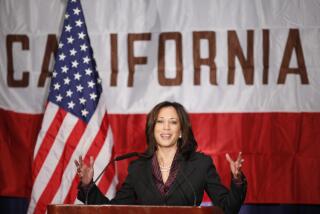Uneasy Bedfellows : Styles Conflict in Health Net-QualMed Merger
- Share via
Health Net and QualMed say their proposed merger would give them two strong assets for battle in President Clinton’s new health care arena: combined revenue of $1.7 billion and a broad geographic reach in the West.
But the success of the $725-million merger, expected to go through by year-end, may well ride on another factor: how these two health maintenance organizations meld their sharply contrasting management styles and personnel.
Analysts say that won’t be easy, especially given their quarrelsome past.
Dr. Malik Hasan, chairman of Pueblo, Colo.-based QualMed, spent a year in the courts trying to force Health Net and its chairman, Roger Greaves, to sell the company to QualMed for $400 million. This even though QualMed is one-third the size of Woodland Hills-based Health Net.
Hasan, 54, a London-trained neurologist-turned-entrepreneur, had had his way in buying numerous HMOs in various states. But Greaves, 55, a shrewd businessman who rose through the ranks of management, methodically held him off. It was a nasty battle, with lawyers and private investigators throwing a lot of dirt at each other.
The dispute ended last month when the merger deal was signed. Greaves and Hasan now say they plan to work together happily as co-chairmen, co-chief executives and co-presidents.
“Dr. Hasan and I have become good friends,” says Greaves.
Perhaps. But analysts remain skeptical about whether the joint management would last.
“They’re now at a starting gate. Soon they’ll be at the touch-and-feel phase. That will probably last six months,” says John Edelston, a health care consultant in Woodland Hills. “After that, I would anticipate no more than a year” before one of them leaves.
The way the merger is set up, it appears Hasan has the upper hand.
Hasan and other QualMed shareholders would have roughly 70% voting control of the combined company. The rest would be held by Greaves and 37 other Health Net executives.
Despite their past differences, Hasan insists the two management teams will get along.
“The integration of the two companies will not be difficult,” he said. “It will be doable.” If they succeed, a merged Health Net and QualMed could be a formidable player in the new health care environment.
President Clinton’s health care reform is expected to direct more business to big HMOs that have economies of scale and a widely spread network of doctors, hospitals and medical suppliers, all of which the combined Health Net and QualMed should have.
The merger provides both companies instant access to markets and business sectors where they are not currently strong. For example, Health Net would get the advantage of QualMed’s deeper experience with Medicare, an area where more people are expected to be switched to HMOs under health care reform.
Greaves says he would oversee the new company’s marketing, finance and human resources departments--which he says are his strengths. Hasan, meanwhile, would be in charge of medical management, developing relations with health providers and seeking new business opportunities.
“They’ve taken some pains to stay out of each other’s way,” said Doug Sherlock, a Pennsylvania analyst who tracks publicly traded HMOs.
Still, there are other, more lasting differences between the two companies that analysts say would be hard to blend.
Those differences are apparent not only in the backgrounds of Greaves and Hasan, but in the paths that each man has taken with his HMO.
Hasan founded QualMed in 1985 by buying a small HMO in Colorado. Since then, he has expanded the company through a series of aggressive acquisitions in New Mexico, Oregon, Washington and California. He moved into Northern California in late 1990 when he bought HEALS, an HMO with 94,000 members.
Analysts say Hasan, having run a publicly traded company since 1991, is more oriented to the bottom line than is Greaves. Last year QualMed earned $19 million on revenue of $436 million. For the six months ended June 30, QualMed earned $12.7 million on revenue of $274 million.
Greaves has been with Health Net since it was part of Blue Cross of California. In 1983, as Blue Cross was reeling from losses, Greaves and Health Net broke away from Blue Cross. Since then, Health Net has grown by methodically focusing on a single market in Southern California: large corporate employers.
Health Net is now the state’s second-largest HMO, behind Kaiser Permanente. Last year Health Net had a profit of $27.5 million on revenue of $1.22 billion. For the first half of this year, it earned $36 million on revenue of $691 million.
Some analysts say Hasan runs QualMed like a chief surgeon with aides at his side, whereas Greaves is wont to make decisions by committee.
“In QualMed you have more centralized decision-making,” said Edelston, the Woodland Hills analyst. “Health Net is more participatory.”
Said Greaves of him and Hasan: “We’re as different as night and day.”
Whether all this points to a quick divorce or not, both Greaves and Hasan have strong incentives to make their new company grow.
Hasan would own about 10.5% of the merged company and Greaves would have a 2% stake. At current stock prices, Hasan’s holding would be worth about $75 million, while Greaves’ would be worth about $15 million.
For Greaves, that’s not bad for the initial investment of $300,000 he made last year when he bought a 3% stake in Health Net when the company converted to for-profit status. But, unlike Hasan, Greaves can’t sell his stake until 1997 because of an agreement with California regulators.
More to Read
Sign up for Essential California
The most important California stories and recommendations in your inbox every morning.
You may occasionally receive promotional content from the Los Angeles Times.











